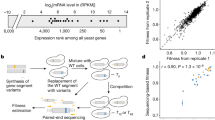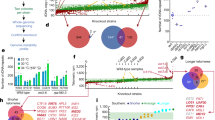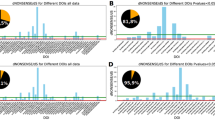Abstract
Deleting a gene in an organism often has little phenotypic effect1,2,3,4,5, owing to two mechanisms of compensation4,5,6,7,8,9,10. The first is the existence of duplicate genes: that is, the loss of function in one copy can be compensated by the other copy or copies. The second mechanism of compensation stems from alternative metabolic pathways, regulatory networks, and so on. The relative importance of the two mechanisms has not been investigated except for a limited study, which suggested that the role of duplicate genes in compensation is negligible10. The availability of fitness data for a nearly complete set of single-gene-deletion mutants of the Saccharomyces cerevisiae genome11 has enabled us to carry out a genome-wide evaluation of the role of duplicate genes in genetic robustness against null mutations. Here we show that there is a significantly higher probability of functional compensation for a duplicate gene than for a singleton, a high correlation between the frequency of compensation and the sequence similarity of two duplicates, and a higher probability of a severe fitness effect when the duplicate copy that is more highly expressed is deleted. We estimate that in S. cerevisiae at least a quarter of those gene deletions that have no phenotype are compensated by duplicate genes.
This is a preview of subscription content, access via your institution
Access options
Subscribe to this journal
Receive 51 print issues and online access
$199.00 per year
only $3.90 per issue
Buy this article
- Purchase on Springer Link
- Instant access to full article PDF
Prices may be subject to local taxes which are calculated during checkout



Similar content being viewed by others
References
Winzeler, E. A. et al. Functional characterization of the S. cerevisiae genome by gene deletion and parallel analysis. Science 285, 901–906 (1999)
Cadigan, K. M., Grossniklaus, U. & Gehring, W. J. Functional redundancy: the respective roles of the 2 sloppy paired genes in Drosophila segmentation. Proc. Natl Acad. Sci. USA 91, 6324–6328 (1994)
Saga, Y., Yagi, T., Ikawa, Y., Sakakura, T. & Aizawa, S. Mice develop normally without tenascin. Genes Dev. 6, 1821–1831 (1992)
Gibson, T. J. & Spring, J. Genetic redundancy in vertebrates: polyploidy and persistence of genes encoding multidomain proteins. Trends Genet. 14, 46–49 (1998)
Normanly, J. & Bartel, B. Redundancy as a way of life—IAA metabolism. Curr. Opin. Plant Biol. 2, 207–213 (1999)
Brookfield, J. F. Y. Can genes be truly redundant? Curr. Biol. 2, 553–554 (1992)
Nowak, M. A., Boerlijst, M. C., Cooke, J. & Smith, J. M. Evolution of genetic redundancy. Nature 388, 167–171 (1997)
Tautz, D. Redundancies, development and the flow of information. BioEssays 14, 263–266 (1992)
Maslov, S. & Sneppen, K. Specificity and stability in topology of protein networks. Science 296, 910–913 (2002)
Wagner, A. Robustness against mutations in genetic networks of yeast. Nature Genet. 24, 355–361 (2000)
Steinmetz, L. M. et al. Systematic screen for human disease genes in yeast. Nature Genet. 31, 400–404 (2002)
Seoighe, C. & Wolfe, K. H. Yeast genome evolution in the post-genome era. Curr. Opin. Microbiol. 2, 548–554 (1999)
Lynch, M. & Conery, J. S. The evolutionary fate and consequences of duplicate genes. Science 290, 1151–1155 (2000)
Conant, G. C. & Wagner, A. GenomeHistory: a software tool and its application to fully sequenced genomes. Nucleic Acids Res. 30, 3378–3386 (2002)
Ohno, S. Evolution by Gene Duplication (Springer, Berlin, 1970)
Causton, H. C. et al. Remodeling of yeast genome expression in response to environmental changes. Mol. Biol. Cell 12, 323–337 (2001)
Pearson, W. R. & Lipman, D. J. Improved tools for biological sequence analysis. Proc. Natl Acad. Sci. USA 85, 2444–2448 (1988)
Kitami, T. & Nadeau, J. H. Biochemical networking contributes more to genetic buffering in human and mouse metabolic pathways than does gene duplication. Nature Genet. 32, 191–194 (2002)
Giaever, G. et al. Functional profiling of the Saccharomyces cerevisiae genome. Nature 418, 387–391 (2002)
Gu, Z., Cavalcanti, A., Chen, F.-C., Bouman, P. & Li, W.-H. Extent of gene duplication in the genomes of Drosophila, nematode, and yeast. Mol. Biol. Evol. 19, 256–262 (2002)
Thompson, J. D., Higgins, D. G. & Gibson, T. J. CLUSTAL W: improving the sensitivity of progressive multiple sequence alignment through sequence weighting, position-specific gap penalties and weight matrix choice. Nucleic Acids Res. 22, 4673–4680 (1994)
Yang, Z. & Nielsen, R. Estimating synonymous and nonsynonymous substitution rates under realistic evolutionary models. Mol. Biol. Evol. 17, 32–43 (2000)
Holstege, F. C. P. et al. Dissecting the regulatory circuitry of a eukaryotic genome. Cell 95, 717–728 (1998)
Acknowledgements
We thank M. Long, T. Oakley, D. Nicolae, K. Thornton, A. Deutschbauer and J. Zhang for discussions and comments. This work was supported by NIH grants to W.H.L and to R.W.D.
Author information
Authors and Affiliations
Corresponding author
Ethics declarations
Competing interests
The authors declare that they have no competing financial interests.
Rights and permissions
About this article
Cite this article
Gu, Z., Steinmetz, L., Gu, X. et al. Role of duplicate genes in genetic robustness against null mutations. Nature 421, 63–66 (2003). https://doi.org/10.1038/nature01198
Received:
Accepted:
Issue Date:
DOI: https://doi.org/10.1038/nature01198
This article is cited by
-
Genome-Wide Identification and Characterization of the AP2/ERF Gene Family in Quinoa (Chenopodium quinoa) and Their Expression Profiling During Abiotic Stress Conditions
Journal of Plant Growth Regulation (2024)
-
Genome-wide identification and analysis of SPL gene family in chickpea (Cicer arietinum L.)
Protoplasma (2024)
-
CAFRI-Arabidopsis: An Intuitive Web-Based Functional Redundancy Inspector in Arabidopsis
Journal of Plant Biology (2024)
-
A flavonol synthase (FLS) gene, GhFLS1, was screened out increasing salt resistance in cotton
Environmental Sciences Europe (2023)
-
The G2-Like gene family in Populus trichocarpa: identification, evolution and expression profiles
BMC Genomic Data (2023)
Comments
By submitting a comment you agree to abide by our Terms and Community Guidelines. If you find something abusive or that does not comply with our terms or guidelines please flag it as inappropriate.



